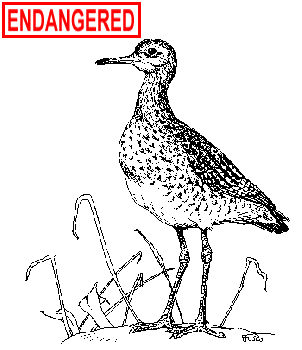Upland Sandpiper
Bartramia longicauda

Habitat: Pastures, upland meadows, fallow fields and similar open, grassy areas.
Weight: 5-7 ounces.
Length: 11-12.5 inches.
Wingspan: 17-20 inches.
Life Expectancy: Oldest reported banded bird was 5 years of age.
Food: Weevils, grasshoppers and crickets; also a wide variety of other invertebrates such as beetles, grubs, moths, ants, flies, centipedes, millipedes, spiders, earthworms and snails; occasionally waste grains, grass seeds and similar plant material.
Status: State endangered.
Identification: Upland sandpipers have long wings; a long tail; small, dark-crowned heads; large, dark eyes; a black-tipped, yellow bill and yellow legs. The sexes are similar. In flight, their blackish primary (outer wing) feathers contrast strongly with their mottled brown upper parts. The call is a rolling trill or flutelike notes, often given in flight.
Range: Upland sandpipers breed from central Maine west through Canada to southern Alaska; southeast to northern Utah, northwestern Oklahoma and northern Texas; and east to central Tennessee, Virginia and Maryland. They winter in South America from southern Brazil to south-central Argentina. The birds leave the pampas early in February, reaching the Gulf Coast of the United States in March. Their major northward migration occurs between the Rocky Mountains and the Mississippi River; however, a smaller migration occurs along the east coast.
Reproduction: Upland sandpipers arrive at their breeding grounds during late April and early May. They prefer to nest in tall, herbaceous vegetation on open grasslands, meadows, prairies and wetland clearings. During courtship, the males circle high overhead and sing with outstretched wings. Nests are hollows 4 to 5 inches in diameter and 2 to 3 inches deep, lined with grasses, leaves and small twigs. The tops of surrounding grasses are often pulled down around the nest to help conceal it. Each clutch usually contains 4 oval, finely speckled, creamy-buff eggs. The eggs sometimes have small reddish-brown blotches and larger lilac markings concentrated at the larger end. The eggs are incubated by both the male and female for 21 days. The downy, precocial nestlings are protected and brooded by the adults until they are full grown (about 30 days after hatching).
Reason for Decline: As passenger pigeon populations declined in the late 1800s, market hunters turned to upland sandpipers as an additional gamebird. The species, once abundant on eastern farmlands and Midwestern prairies, experienced a population decline due to overhunting. The birds have not been able to regain their former numbers.
History in Connecticut: The clearing of woodlands for farms in the early 1800s increased available habitat for upland sandpipers. Through the mid-1800s, the species was a common breeder in Connecticut and appeared in great numbers during migration. However, populations in Connecticut dropped dramatically around 1900, and by 1908, the species was considered rare in many areas of the state. Upland sandpiper habitat is shrinking as developments and forests replace agricultural lands, slowing the population growth of the birds. Upland sandpipers are considered threatened or endangered in most New England states. Only 3 Connecticut breeding localities have been confirmed in the past decade. Upland sandpipers are beginning to adapt to land use changes in Connecticut by using other open croplands and alfalfa fields. They are also occasionally found during migration in flocks with killdeer and horned larks at airports.
Interesting Facts: The upland sandpiper is unlike other sandpipers or plovers in that it prefers dry, open, grassy habitats rather than wetlands. It does, however, share a predator response with wetland-loving plovers. When disturbed, upland sandpipers will run a short distance and "freeze" in an attempt to blend into surrounding habitat and confuse a predator. These two characteristics are reflected in the birds' early common names, upland plover and highland plover.
During migration, 20-30 snails of the genus Physa are often found clinging to feathers under the wings of upland sandpipers, enabling the snails to be transported over great distances.
Protective Legislation: Federal - Migratory Bird Treaty Act of 1918. State - Connecticut General Statutes Sec. 26-93 and Sec. 26-311.
What You Can Do: Protection of farmlands, fields and similar open areas in Connecticut will greatly assist the recovery of the upland sandpiper.

The production of this Endangered and Threatened Species Fact Sheet
Series is made possible by donations to the Endangered Species/Wildlife Income Tax
Checkoff Fund.
(rev. 12/99)

